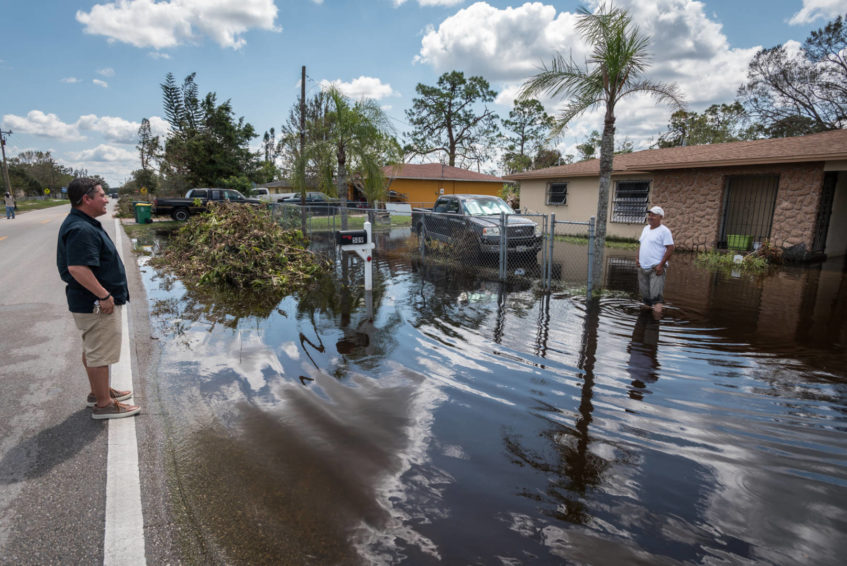Image credits: World Vision
Last year’s hurricane season in the Atlantic Basin was not only devastating in terms of the number of fatalities and unprecedented damage and destruction to infrastructure, It also signals the emergence of a new trend of unfamiliar, above-average storm activity that will continue as global temperatures keep rising.
September of 2017 was the most active month for hurricanes on record, with 10 consecutive hurricanes hitting the Caribbean. Two reached Category 5 strength. Overall, the region was struck by 10 hurricanes and six major hurricanes (Category 3 or stronger), while the 30-year average is six and two, respectively. Another troubling factor is the speed at which the storms intensified: Maria grew from a tropical storm to a Category 5 hurricane in a little over a day, a process which usually takes a few days to a week. Also unfamiliar was the devastating duration of the hurricanes’ peak intensity. Irma, for example, retained Category 5 status for three consecutive days in the Atlantic and held on to its peak intensity – 185 mph – for 37 hours, setting a world record.
This physical intensity of the storms caused tremendous suffering for island residents. The 2017 hurricane season was one of the deadliest on record as well as the costliest, with an estimated $281 billion in damages. Maria exacted a devastating toll on Puerto Rico, leaving more than 90 percent of the island without power and destroying more than 80 percent of the island’s crops. The island of Barbuda was rendered nearly uninhabitable after Irma’s direct strike on the island, which damaged or destroyed at least 95 percent of the island’s infrastructure. The British Virgin Islands, as well as many other islands in the region and the U.S. coast, were ravaged by the intense hurricanes, which caused an historic level of destruction.
Several of these areas are still grappling with the effects of the storms many months after their passage. In Puerto Rico, 30 percent of the population is still waiting for the electricity service to be restored and many residents are now facing the possibility of water rationing due to shrinking water supplies. Most of the residents of Barbuda remain off the island, with government officials estimating that it will take around six months for half of the population to return. In the British Virgin Islands, students are still going to school in shifts, as the local high school has not yet been repaired and, according to aid workers, the devastation is so widespread that the return to normal conditions is still far in the future.
A Climate-Sensitive Region
The Caribbean region is disproportionately vulnerable to climate change compared to other regions of the world. This vulnerability is partly due to its dependence on economic activities like agriculture and tourism, which together employ approximately 43 percent of the region’s labor force and are highly dependent on favorable climate conditions and predictable climate patterns. (1)
Climate sensitivity in the area is increased by geographical factors. Many of the small islands in the region are low-lying or have mountainous interiors with narrow coast lines. There is thus a limited amount of land available for the location of infrastructure, population settlements and agricultural and industrial activities outside of climate sensitive areas like narrow coastal areas or steep hillsides. Relocation opportunities within these islands in the event of natural disasters are also limited for the same reasons.
These factors are compounded by the fact that many countries in the Caribbean rely primarily on the groundwater, surface water or rainwater harvesting for their water supply, which is recharged by rainfall during the course of the year. The region’s water supply is thus extremely sensitive to rainfall variations. (2)
According to the IPCC (Intergovernmental Panel on Climate Change), operating under the United Nations, surface temperature in the Caribbean has warmed by about 0.8 degrees Centigrade between 1901 and 2012. (3) Almost every successive month in the Caribbean over the last two years has been recorded as the record warmest. This dramatic increase in temperatures has led to a number of significant changes in the region’s climate patterns and to increasingly unfamiliar and unpredictable climate events.
The number and intensity of tropical storms and hurricanes has increased dramatically since 1995. In addition, the area has seen repeated and prolonged episodes of drought in recent years, with an increase in the number of very hot days, coupled with intense rainfall events causing repeated localized flooding. Rising sea levels caused by thermal water expansion and the melting of glaciers and ice sheets are consuming the beaches on which the region’s important tourism industry is based. Changes in water temperature and pH have also led to a decline of coral reef ecosystems, which are vital to the region’s economy. More than $3 billion are generated annually from tourism and fisheries, which rely heavily on coral reefs. These industries, in addition to other goods and services industries related to these ecosystems, support more than 43 million people. (4)
An Uncertain Future
If no significant global action is taken by the end of the current century to mitigate climate change, the Caribbean region will warm a further 2 degrees, 3 degrees Centigrade or more above the 1 degree Centigrade increase seen in the last century. Rainfall amounts will drop by up to 40 percent and sea levels will rise by 1-2 meters, far exceeding the rise seen during the last century. In addition, the region will see more of the strongest tropical Atlantic hurricanes, if not more overall.(5)
Climate changes in the area are such that according to scientists like Dr. Michael Taylor, a professor and researcher of the University of the West Indies in Jamaica, they seem to be indicating the emergency of a new climate regime. According to Taylor, “Cumulatively, the science of projections suggests that the region’s climate will be altered beyond recognition. This is to say, it will be outside the bounds of our lived experience to date. It will not just be unfamiliar at times, it may be unprecedented all the time.” (6) In addition to the devastation caused by unpredictable weather events, these changes will permanently alter the regularity of the seasonal climate cycles on which Caribbean life and economic activity largely depends.
In the face of these challenges, the countries of the Caribbean have taken steps in recent years to increase their adaptability to climate change. These steps include new investments in climate-resilient infrastructure and practices, as well as measures to ensure adequate preparation and facilitate quick responses to emergency needs.
With the start of the next hurricane season just three months away, the heads of government of the Caribbean Community (CARICOM) met in Haiti in late February of this year, with climate change at the top of their agenda. Regional leaders indicated that the occurrences of the 2017 hurricane season signaled “the advent of a ‘new normal’ to which the Caribbean countries must adapt.” Efforts are being made to establish or strengthen funding mechanisms for disaster risk and to obtain funds for climate resilience projects in the region.
Last November, the United Nations Development Programme (UNDP) announced it had collected over $1.3 billion in pledges from international governments to help Caricom mitigate climate change. The Green Climate Fund (GCF), also established within the framework of the UN, approved $1.09 billion in funding in late February for low emission and climate resilient development projects in the region. Nevertheless, considering that the last hurricane season alone will cost the region over $280 billion in damages, these numbers seem woefully insufficient.
In recent years, the Caribbean Community Climate Change Centre, established by Caricom in 2005, has been charged with developing climate change adaptation strategies for member states in order to reduce their vulnerability to climate change and help them switch to renewable and cleaner energy sources. The region has also made bold commitments at the United Nations Climate Change Conference regarding future greenhouse gas emissions. However, despite the fact that the region is among the first to be significantly impacted by climate change, it contributes less than 1 percent of global carbon emissions. It is clear that without significant global action, no meaningful changes can be achieved in the region to mitigate the devastation caused by climate change.
In the face of increased threats to sustainability and survival if global inaction continues, the UN has refused any binding measures to combat greenhouse gas emissions. After the categorical failure of 1997 Kyoto protocol, which included legally binding targets for greenhouse gas emissions, pledges to reduce emissions under the Paris Agreement under the United Nations Framework Convention on Climate Change are entirely voluntary. The pledges made thus far – if kept — will inevitably result in global warming levels well above the 2 degrees Centigrade mark that has long been considered unacceptably risky. The prevention of global warming levels of no more than 3 degrees Centigrade now hinges on the irrational hope that signatory countries will voluntarily increase their emission reduction ambitions every five years.
Even the modest goals established under the Paris Agreement seem entirely unrealistic, considering that the biggest polluting countries have consistently refused to take significant action to reduce emissions. In addition to the Trump administration’s withdrawal of the US from the Agreement, which drew significant media attention, major polluters who are still parties to the accord like China and India continue to build coal plants at home and around the world. Chinese corporations are now planning to build more than 700 new coal plants, including in some countries that today burn little or no coal, and India’s state-run power utility plans to invest $10 billion in new coal-fired power stations over the next five years. (7)
Atmospheric carbon dioxide levels hit a record high last year, breaching the 410 parts per million threshold, the highest it has been in all of human history. These levels have increased each year since measurements began and are now rising at record rates, clearly indicating that the world is still on track for ‘worst case’ scenarios in terms of rising sea levels, changes in weather and oceanic circulation patterns and reduction of agricultural capacity. The Caribbean is disproportionately vulnerable to all of these devastating effects. Beyond the question of the region’s capacity to adapt to these new threats is the question of what it will take to achieve the global action required to mitigate them. It is exceedingly clear that relying on commitments made by heads of state under accords such as the Paris Agreement is not the answer.
(1) Taylor, Michael. Why Climate Demands Change (GraceKennedy Foundation, Jamaica, 2015), 13.
(2) Ibid., 14.
(3) IPCC, Climate Change 2014, Fifth Assessment Report.
(4) Aldred, Jessica. Caribbean coral reefs ‘will be lost within 20 years’ without protection. The Guardian, July 2, 2014.
(5) Taylor, Michael. Climate change in the Caribbean – learning lessons from Irma and Maria. The Guardian, October 6, 2017.
(6) Ibid.
(7) Institute for Energy Research. Despite the Paris Agreement, China and India Continue To Build Coal Plants. July 24, 2017











